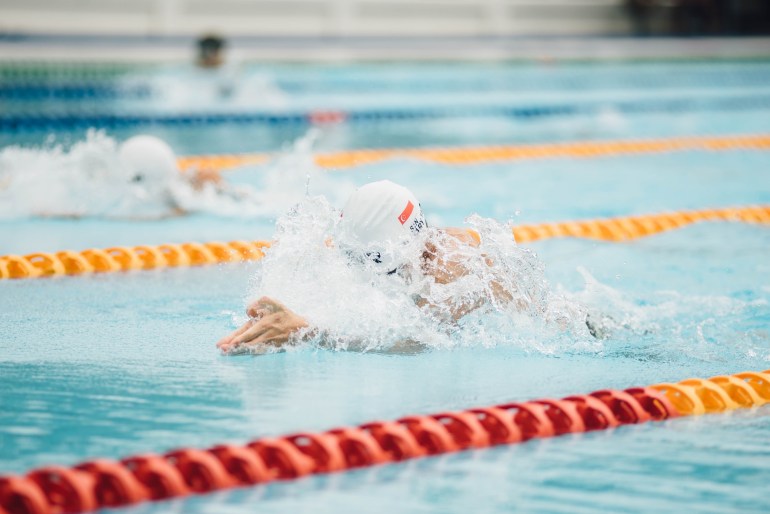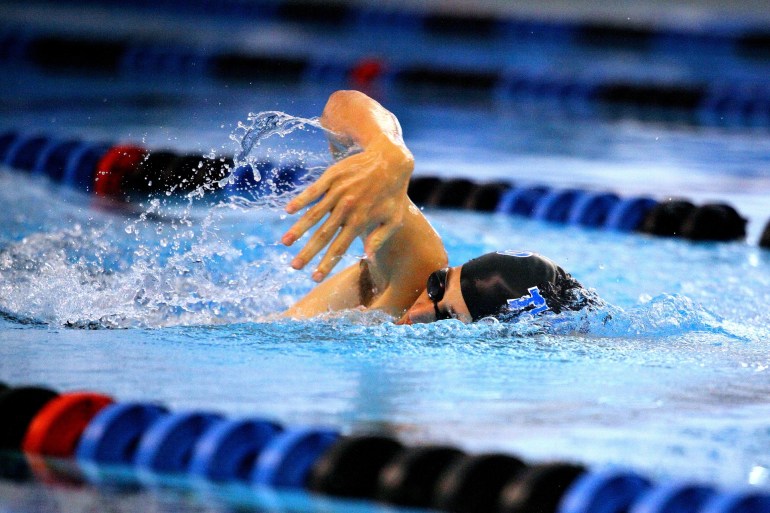Disappointing numbers.. Why did swimmers become slower in the Paris Olympics? | Science
The swimming competitions at the Olympic Games currently being held in the French capital, Paris, are witnessing a lower presence of records compared to previous sessions, as only a new world record was recorded over the course of 6 days of competition, and the women’s 400-meter freestyle race failed to break the previous world record, despite the large promotional campaign that this race received to the point of describing it as the “race of the century”, due to the presence of 3 swimmers who hold world records among the competitors.
This brings back to the forefront what was reported before the start of the Olympic competitions, as coaches and experts indicated their fears about the depth of the Olympic pool in which the competitions are held, as its depth is not considered optimal and this negatively affects the speed of the swimmers.

Is there a slow pool?
The depth of the La Défense Arena swimming pool, where the current competitions are taking place, is 2.15 metres. Although the minimum depth required by the International Aquatics Federation is 2 metres, some experts believe that 2.15 metres is not ideal, comparing it to the pools in the previous Tokyo and Rio Games, which were 3 metres deep, which experts believe is the ideal depth for a swimming pool. It is worth noting that the Tokyo 2021 Games witnessed the breaking of 6 world records in swimming competitions, while the Rio 2016 Games witnessed the setting of 8 new records.
This view is based on physics. The movement of swimmers in the water generates waves that spread through the pool longitudinally and downwards, where they hit the bottom and bounce back to the surface, creating disturbances that slow down the swimmers’ speed, because they produce a wavy surface that requires more force to displace the water while swimming, i.e. the water resistance increases.
For this reason, the water is calmer as the pool depth increases, because the waves that are created bounce off over a longer period of time, while a shallow pool causes more waves to bounce off, making the water more turbulent and increasing its resistance, which has a negative effect on the swimmer's speed.
If sound waves travel in water at 1500 meters per second, then it takes less than 3 milliseconds for the wave to bounce back to the surface in a 2.15-meter-deep pool, compared to 4 milliseconds in a 3-meter-deep pool. Although the difference may seem very small, it is significant in a sport where the winner is decided in milliseconds.
“Yes, it does affect performance,” Dr. Good Reddy, deputy director of innovation and principal research engineer at the Georgia Institute of Resources Technology, told Al Jazeera Net. “The pressure waves created by the swimmers’ arms and legs are transmitted and reflected back to the surface, creating roughness (irregularity) on the water, which the swimmers must push off while floating.”
Longer competitions are more affected.
The Olympic swimming pool is 50 metres long, and because the ripple effect of the waves increases as people move through the pool, the first lap (the first 50 metres of the race) will not cause much disturbance in the pool, but will gradually increase as the competition progresses. The greater the distance the competition is, the greater the effect of the waves. This means that the medium and long-distance swimming races at the Paris Olympics, such as the 400-metre or more events (in which swimmers cross the pool 8 or more times), will be more affected than the shorter distance events.
The numbers seem to suggest this. In the women’s 400m freestyle, Australian champion Arianne Titmus won the gold medal, more than two seconds shy of the world record set by the same champion last year, while Chinese swimmer Pan Zhanle broke the world record in the 100m freestyle, the only world record set so far in the current edition.
Others, however, believe that the slow pool theory is not true. The evidence is that the swimming competitions held in the first four days of the current Olympics resulted in winning 7 competitions with times faster than those witnessed in the last Games in Tokyo, and 7 other competitions were slower and one competition was exactly the same as the last Olympics. This means that the general field was not affected despite what is being said about the slow pool.
In the same context, John Ireland, Technical Services Manager at the American company Myrtha Pools, which builds swimming pools, points out that the difference between a swimming pool that is 3 meters long and 2.5 meters long is nothing.
But Reddy, in his statement to Al Jazeera Net, confirms that the difference is not only related to the rebound of the waves, explaining that “the irregularity in the water surface is often uneven, because it depends on the swimmer’s position in the pool in relation to the other swimmers. For example, a swimmer in the middle lanes may face higher wave effects than swimmers in the outer lanes.”
What Reddy means is that the shallowness of the pool also increases the inequality of opportunity, because swimming in the middle of the pool is affected by the irregularity of the water from all surrounding directions, while this momentum is reduced in the case of swimming in the edges.
The inequality of opportunity is repeated again in the swimmers' rankings, as Reddy explains that being in front, especially in short-distance events, creates an advantage over trying to come from behind and having to push through the water's irregularities.
Dr. Reddy adds that this effect will be barely noticeable to most readers who know how to swim (such as non-competitive swimmers) but in Olympic-caliber races decided by 0.01 seconds or less, any small resistance of the water has an effect that is taken into account.
Asked why swimming pools sometimes don't reach 3 metres since deeper pools are associated with better performance and smoothness, Reddy replied: “If the pool goes deeper than 3 metres, it will actually have a negative effect. Although the energy from the reflected waves will be minimal at the surface, the mental effects on the swimmer will make him feel slower.”
The issue is similar to boarding an airplane, because the passenger feels that the flight is going slowly when the plane is high, and in contrast, the passenger feels the speed of the plane during take-off and landing, even though the actual speed of the plane throughout the flight is higher than its speed during the landing and take-off phases.
Some swimmers actually think that swimming in a shallow pool makes them feel like they're swimming faster even though their times don't support that, Reddy adds, but the other option, making the pools shallower, seems to have had a clearer negative effect on the records.

Beijing plot?
The Olympic swimming pool crisis has gone so far as to be described as deliberate and a conspiracy by the organizers, with observers considering it a form of revenge for events that took place 16 years ago at the 2008 Beijing Olympics, when the American team snatched the gold medal in the 4×100 freestyle relay from its French counterpart in what was described at the time as the greatest swimming event of all time.
Accordingly, conspiracy theorists believe that the construction of a shallower pool was a deliberate act by the French, because they know that American swimmers rely more on swimming underwater, and therefore they will be more affected than others by subsurface waves bouncing off the bottom.
It is noteworthy that the Olympic Games held in Beijing in 2008 witnessed the largest breaking of world records in swimming, as swimmers achieved 25 records during it, which is considered the largest number of world records achieved in this sport since 1976.
Many credited the high-tech LZR Racer swimsuit, made of polyurethane, with reducing water resistance, leading IAAF to ban the use of this type of swimsuit following Beijing 2008.
The Racer suit worked through several mechanisms, reducing the friction between the skin and the water, which limited the amount of water the swimmer's body dragged along with it while floating, because polyurethane is a plastic material that can repel water. NASA, which collaborated on the suit's development, reported that the skin's friction resistance was reduced by 24 percent with the suit.
